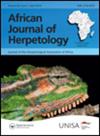Tropidosaura essexi Hewitt, 1927 (Reptilia: Lacertidae) is live bearing: the only viviparous African lacertid
IF 0.9
4区 生物学
Q3 ZOOLOGY
引用次数: 0
Abstract
ABSTRACT Viviparity has evolved independently multiple times within squamate reptiles. In the Lacertidae, two genera and several species from the Northern Hemisphere are known to be viviparous. However, although viviparity is present in many African reptiles, all African lacertids were considered exclusively oviparous. The lacertid genus Tropidosaura is restricted to mountainous grassland habitats across central and southern South Africa. Prompted by the dissection of a gravid T. essexi specimen containing well-developed embryos, we dissected additional gravid females from two museum collections to assess parity mode in the four Tropidosaura species. Gravid females of three species contained developing eggs, but all gravid Tropidosaura essexi specimens examined exhibited simple placental development or contained well-developed embryos with the presence of a simple placenta and an absence of any eggshell. The large yolks and simple placentae suggest that viviparity in T. essexi is lecithotrophic. T. essexi thus represents the only known viviparous species of lacertid in Africa and therefore, the first known viviparous lacertid in the Southern Hemisphere, revealing yet another independent case of the evolution of viviparity within the squamates. T. essexi occurs at higher maximum elevations than any of its oviparous congeners, and the recorded litter size in T. essexi was slightly higher than the clutch sizes of other members of the genus. Previously reported oviparity in T. essexi may either be the result of specimen misidentification or potential bimodal reproductive in this species, but this latter explanation is unlikely, given that none of the T. essexi examined in this study showed evidence of oviparity.休伊特三角龙,1927年(爬行动物纲:乳虫科)是非洲唯一的胎生乳虫
摘要胎生性在鳞片爬行动物中已经独立进化了多次。已知北半球的两个属和几个物种是胎生的。然而,尽管许多非洲爬行动物都有胎生现象,但所有非洲草类动物都被认为是卵生的。热带苔草属仅限于南非中部和南部的山地草原栖息地。在解剖一个含有发育良好胚胎的怀孕埃塞西T.essesi标本的推动下,我们从两个博物馆藏品中解剖了更多的怀孕雌性,以评估四个热带物种的交配模式。三个物种的妊娠雌性都有发育中的卵子,但所检查的所有妊娠西回归草标本都表现出简单的胎盘发育,或含有发育良好的胚胎,存在简单的胎盘,没有蛋壳。大的蛋黄和简单的胎盘表明,埃塞西的胎生是非营养性的。因此,T.essesi代表了非洲唯一已知的胎生草动物,因此也是南半球第一个已知的胎动草动物,揭示了另一个独立的鳞片胎生进化案例。埃塞西T.essesi的最高海拔比其任何产卵同类都高,而且埃塞西T.Essesi记录的产仔数略高于该属其他成员的窝数。先前报道的埃塞西T.essesi的产卵可能是标本鉴定错误或该物种潜在的双峰繁殖的结果,但后一种解释不太可能,因为本研究中检查的埃塞西T.都没有显示出产卵的证据。
本文章由计算机程序翻译,如有差异,请以英文原文为准。
求助全文
约1分钟内获得全文
求助全文
来源期刊

African Journal of Herpetology
ZOOLOGY-
CiteScore
3.00
自引率
6.70%
发文量
15
审稿时长
>12 weeks
期刊介绍:
African Journal of Herpetology (AJH) serves as an outlet for original research on the biology of African amphibians and reptiles. AJH is an interdisciplinary journal that publishes original articles and reviews from diverse fields and disciplines, such as conservation, phylogenetics, evolution, systematics, performance, physiology, ecology, behavioural ecology, ethology, and morphology.
The Journal publishes two issues a year. There are no page charges .
 求助内容:
求助内容: 应助结果提醒方式:
应助结果提醒方式:


